 |
Chitho
Chithos are usually sandstone discs for softening skins by abrading them over their rough edge. Most are roundish but some are rectangular, square, lanceolate, tear or bell-shaped and pentagonal, plans that may relate to their use. These simple tools-of-the-moment are in a dozen sites, mainly near treeline where caribou skins are prime in late autumn after warble fly holes have healed. |
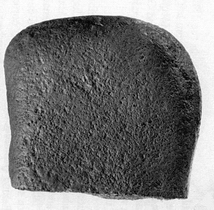 |
Core
A core is a reservoir of workable stone used for producing tools via flake or blade removal. The only true Beverly blade cores are ASTt, but rare Taltheilei quartzite ones are bladelike. Cores may be round, cubic, flat, keeled, pyramidal, conical, cylindrical or amorphous. They may have one or both ends or a side percussed from a single or a rotated striking platform, resulting in few flake scars or many surrounding blade scars like a fluted Greek column. |
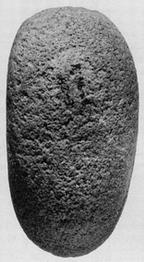 |
Hammerstone
A hammerstone is often a long symmetric pock-marked tool of quartzite or shock-resistant granite and basalt. Used most frequently for stone-knapping, splitting cores and thinning large core flakes, hammerstones could also have been used for any tasks where hammering was needed, like tent pegs.They usually have round ends, one often larger than the other, and one or both pock-marked from hammering. Some are pockmarked equatorially midway. |
 |
Knife
Except for elegant finely retouched and colourful ceremonial ones, knives were tools-of-the-moment; quickly made and sharpened as needed, and easily discarded, as seen in abundant fragments. Mainly butchering tools for caribou, they were used on other game, fish, birds, plus sundry other tasks. They were of all types of rock and were bifacial or unifacial. Importants traits to look for in the trait list are striated or worn used knives, serrated unworn knives, transversely broken used knives, diagonally broken knives destroyed in manufacture, blunted backs on worn knives and basal wear on used knives. |
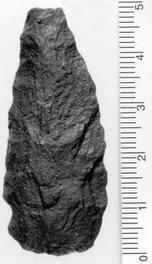 |
Point
Points are usually symmetric elongated culturally-diagnostic hunting tools of shock-resistant quartzite or chert, but some are basalt or silicious shale. Used for killing mainly caribou, they may be confused with symmetric lanceolate bifacial knives. Unless retouched away, most points have striking platforms at the haft opposite a sharp tip. Do differential male-female sex roles apply to points? Yes, not only by Hearne and other explorer’s accounts, but in almost all big mammal hunting societies it is an exclusive male activity. In fact, a cross-cultural survey shows that of 179 societies, males do the hunting exclusively in 166 and both sexes participate in 13. 1 1 Murdock, G. P. *Culture and Society*, Pittsburgh: University of Pittsburgh Press, 1965. |
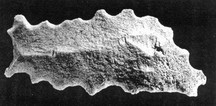 |
Saw
The simple plan and use of saws and denticulated toothlike worked stone suggest they were simple tools-of-the-moment, requiring elementery shaping and notching. As their traits overlap significantly, cultural separation of surface saw or denticulates using clustered traits appears impossible. Details |
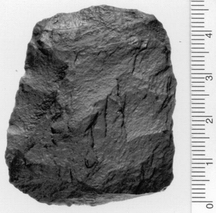 |
Scraper
Most scrapers are either quartzite or chert, with rare basalt. All were used for scraping hide, but may have been used on organic materials of wood, bone and antler. A few are striated, allowing analysis of application forces and angles in functional interpretation. Many have thinned hafts. Striae occur most frequently on the bit rather than ventral surface like pushplanes, indicating oblique angles of application. Some are so rounded that retouch is obliterated. Scraper application is >30 deg. to the work, often 45 deg. Some rare huge endscrapers resemble some abruptly flaked flat cores and core tablets, but are separable using telltale wear. Five types of scrapers are symmetrical end, combination, discoidal and bifacial scrapers, and asymmetrical sidescrapers. Except for discoidal scrapers and rare scrapers with scraping edges at both ends, scrapers have two parts: an abruptly retouched scraping bit at the tip and/or sides; and a retouched or unretouched supporting base and midsection, sometimes called a handle or haft. Symmetrically retouched or unretouched tanged or stemmed scrapers were inserted in antler or bone handles, while unretouched sidescrapers were often hand-hafted. |
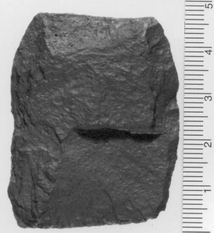 |
Wedge
Beverly wedges are usually symmetric elongated bipolarly-pocked tools of shock-resistant quartzite. Often used for splitting organic materials of wood, bone and antler, wedges may be confused with bipolarly struck flakes. Some wedges have double bipolar striking platforms, one on each side of a square. Most, however, have two platforms unless one has been retouched or shattered away. Wedges may have pointed ends, sometimes of differing size. Like chithos and hammerstones, they were simple tools-of-the-moment. |
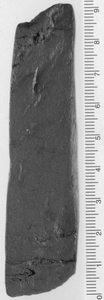 |
Whetstone
Most whetstones are symmetric elongated bifacial tools of abrasive sandstone or polishing mudstone for sharpening the edges of stone and copper instruments or smoothing their faces. Often symmetric in side profile and called bar whetstones, some were suspended via notching. Whetstones are usually flat on both top and bottom surfaces. A few are retouched, but most are plain. Whetstones are related to edge grinders in tool preparation except the latter are grooved and made of sandstone. Whetstones may be striated and heavily worn. They occur in all phases of Beverly prehistory. They are simple tools-of-the-moment like sandstone chithos, but as their raw differed from other tools and was not universally available, they were probably curated and carried by herd-followers. |
For further definitions and abbreviations, visit our Glossary.